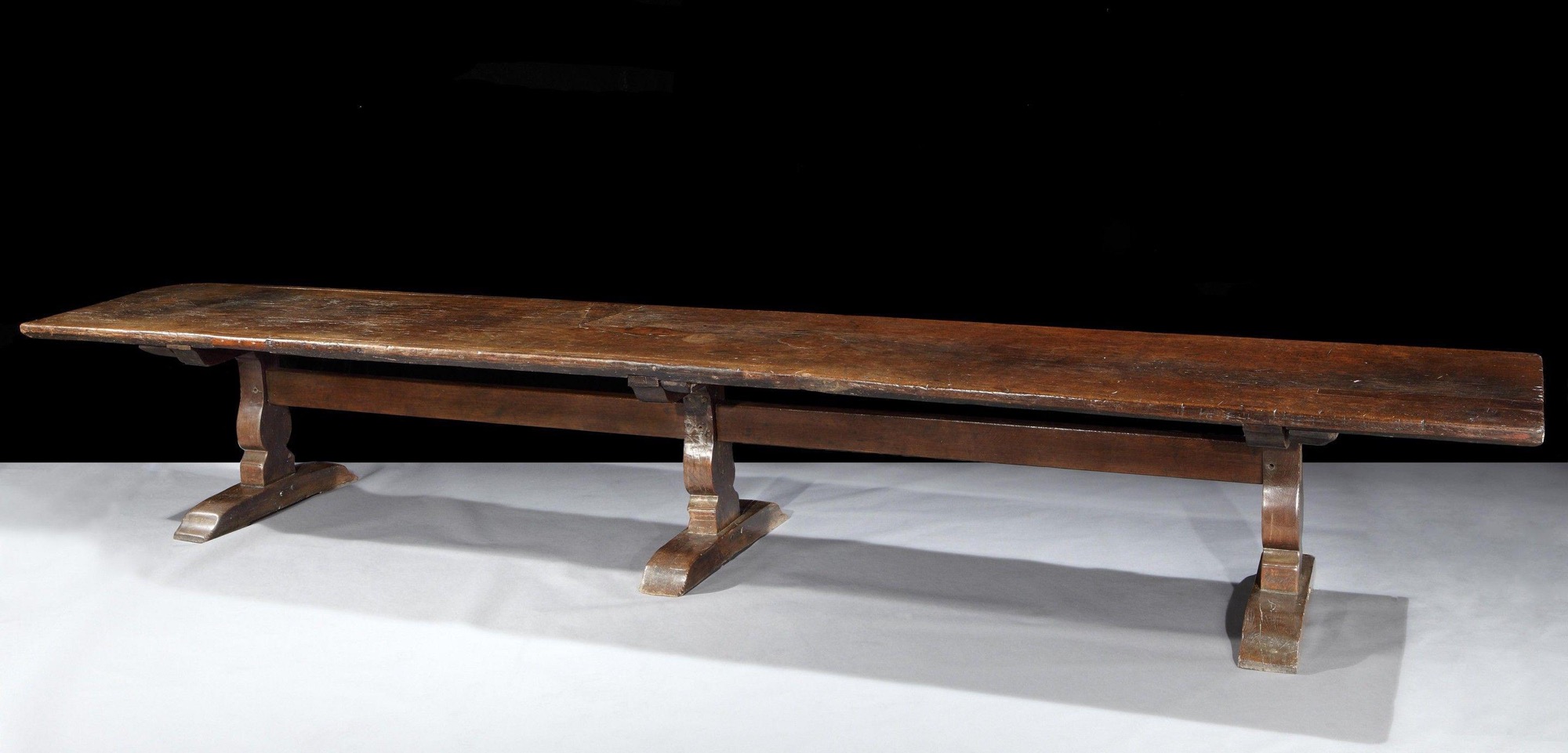A massive late-17th century, oak trestle table with the 16ft 5 in top made from a single plank of timber, from the late J P Getty Collection, Sutton Place
10145
The magnificent, plank top is made from a single plank of oak. It has one rounded corner and a few old patches in areas that have been affected by woodworm and where there were knots in the timber. The table stands on three, large and elegant, vase-shaped, trestle supports which have platform bases. The trestles are joined by a single stretcher. The colour and patina of the table are exceptional.
Genuine examples of long trestle tables are scarce. Although much earlier in date the two magnificent single plank trestle tables at Penshurst are similar in that the surface nd colour of the oak has the same grey patinated surface with all the signs of obvious antiquity. The early 17th century examples from Hatfield House are another example, although they are so exceptional in character and ornament that they cannot be regarded as either a direct comparison or typical of the time.
Tables of trestle construction, made from massive boards of oak or elm resting on a series of central supports, were the most common type of early dining table. The tops were detachable and the entire table was frequently removed after meals. Such tables 'wth trestelys' are often listed in inventories as early as the 15th century when tables of great length and solidity were required for banquets. Tudor inventories abound with references to 'a table wth trestilles' or 'a table with a payer of trestilles'. Trestle tables continued to be popular in the 17th century probably because they were so readily removable when a room had to be cleared for dancing and other revels. In Romeo & Juliet, Capulet instructs the servants to clear the hall and 'turn the tables up' for dancing. Even as late as 1649 there was 'a Long Table standing upon antique tressells' among Charles I's furniture at Greenwich.
17th Century
1675
Oak
England
The late J P Getty Esq, Sutton Place. Inventory Number BRITFRN/162. The table has, by repute, been at Sutton Place since before the 19th century. The great renaissance mansion of Sutton Place was the creation of Sir Richard Weston, Henry VIII's loyal and influential courtier. Shrouded in mystery and romance, it is reputed that Anne Boleyn and the King first met in this house, Sir Richard's son lost his head for his closeness to this most tenacious of Henry's wives. The early Tudor house was constructed between 1521 and 1533 in red brick, and in the newest style, most clearly evident in its symmetrical plan and the use of terracotta in the decorative Italianate panels nd the window mullions. Probably constructed by the same builders that had worked on Hampton Court, the house has lost its north range and gate house, which, before 1782 completed the courtyard. Sutton Place remained in Weston ownership until the end of the 19th century after which it passed through a succession of owners, from the press baron Alfred, Lord Northcliffe and George, 5th Duke of Sutherland, to the American millionaire John Paul Getty who died in the house in 1976. Each successive owner has left his mark on the building, from the Tudor ceiling and panelling created for Mr Getty to the recently created antiquarian library. Each owner has filled its spaces with interesting and ecclectic furniture, specifically oak and walnut which harmonises so subtly with its period interiors. LITERATURE: Country Life 14th February, 1914. English Homes, Early Tudor, Period II, 1924, volume 1, (Avery Tipping). The Architectural Review, August 1913. Some Famous English Country Homes, 1951.
REFERENCE : The Dictionary of English Furniture (Edwards), Tables, Dining and Hall, Figure 3, illustrates one of the pair of trestle tables at Penshurst Place. Figure 5 illustrates one of a pair at Hatfield House.












